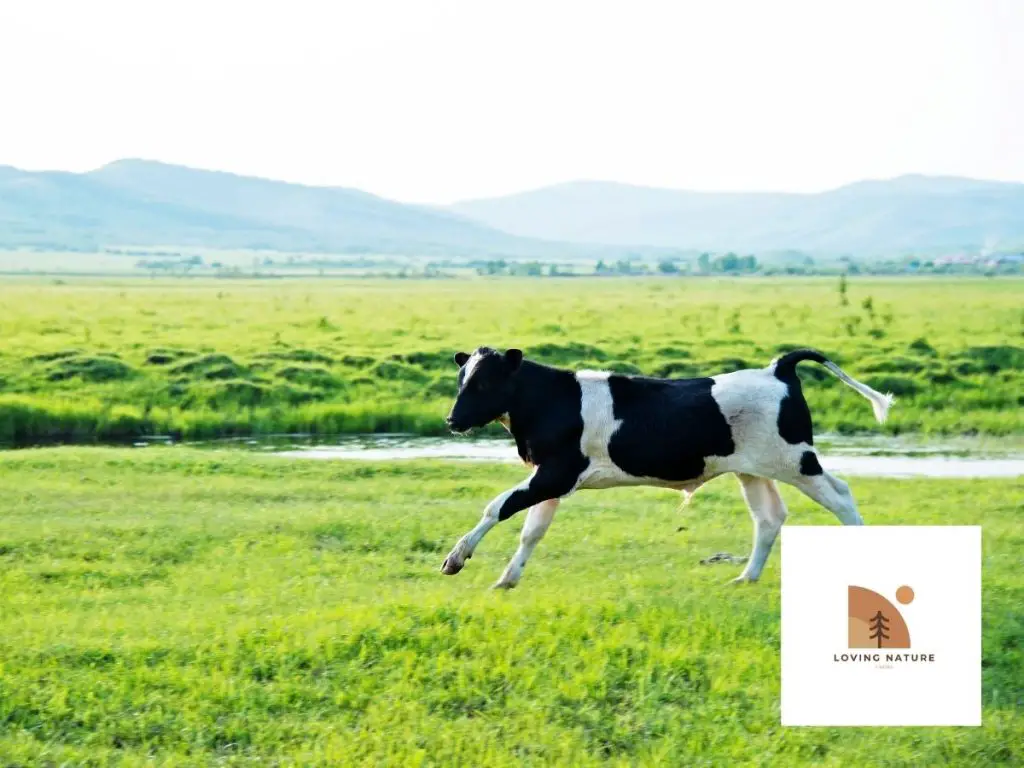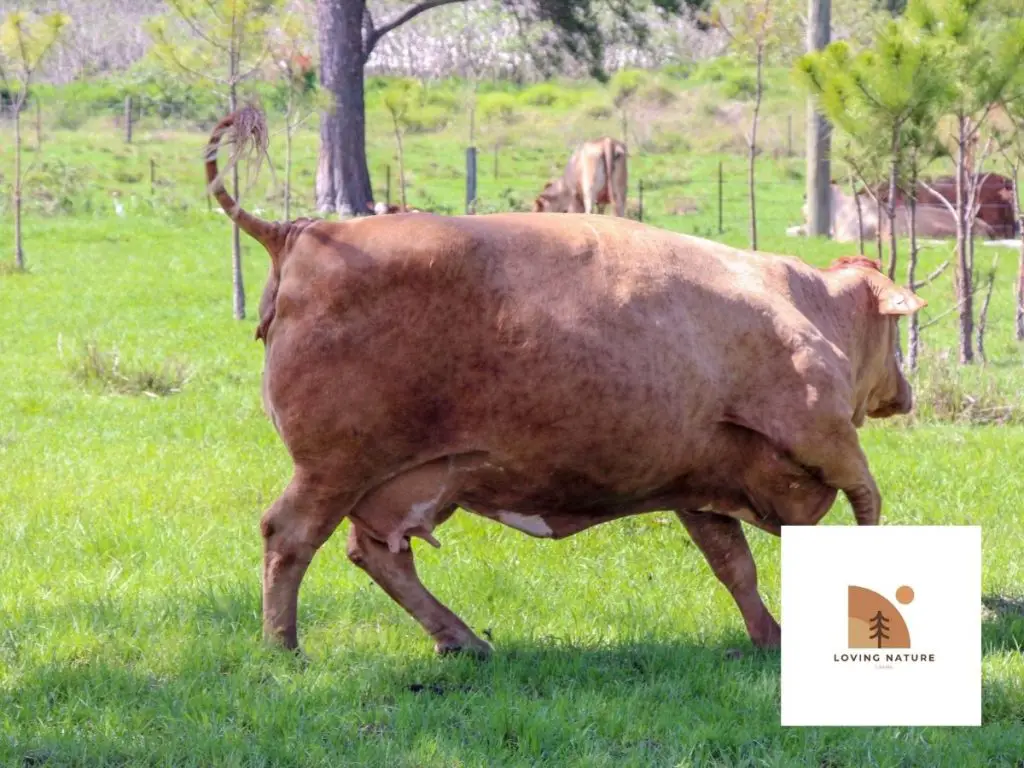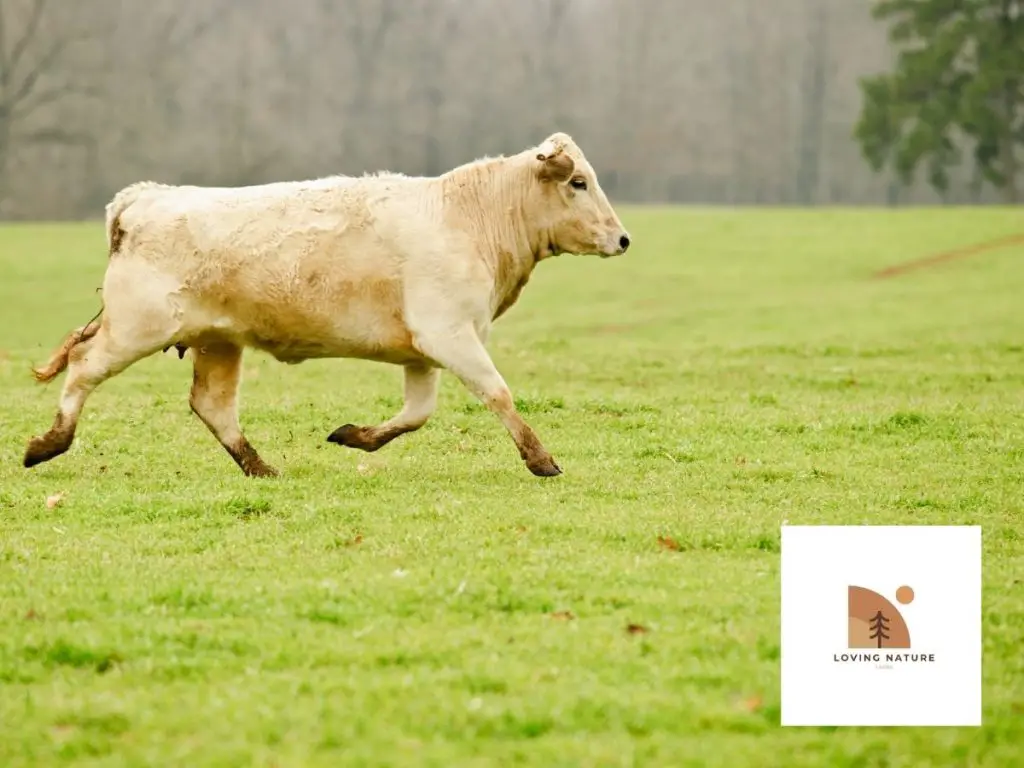Do you know how fast a cow can run? Neither did we, until we did some research for this blog post. It turns out that cows are pretty speedy animals, and they have a few other interesting attributes worth mentioning. In this article, we will explore the topic of cow speed as well as some of the other unique things about these creatures. We hope you enjoy!
Did you know that cows can run up to 25 mph? Yes, that is right. A cow is capable of running up to twenty five miles per hour, or forty kilometers per hour. This is a pretty impressive speed compared to the speeds of other animals. For comparison, the fastest animal in the world is the peregrine falcon, which can reach speeds of up to 242 mph, or 389 kph.

How High Can A Cow Jump?
Despite what you might think, cows can jump. In fact, they are capable of jumping up to 6 feet in the air. A happy cow, however, can easily clear a five foot fence. In addition to being capable of jumping high, cows also prefer to walk. Hence, it is important to learn the proper way to train a cow for jumping. Here are a few tips to train a cow for jumping.
Make sure the fence is tall enough. Cows are notoriously stubborn, and they are capable of jumping higher than most people believe. If you want to secure your cattle from escaping, you need to make sure that the fence is high enough to prevent them from jumping. You can use wire mesh or electric fencing, but be sure to place enough feed inside the enclosure to prevent them from escaping. If you don’t have an electric fence, make sure that you have a fence with a low enough height. That way, your cow won’t want to escape for food, which will prevent them from jumping.
Unlike horses and other animals, cows can jump at a high altitude if they need to. Because of their immense mass and fragile hooves, cows are naturally prone to jumping, and this is often used by bulls to gain access to female cows in heat. Even if they are capable of jumping, they prefer to walk. However, they can jump to reach food or avoid predators.
Cows may not have the courage to jump high, but this doesn’t mean they’re insecure. The animals jump for joy. They’ll do whatever they can to get their attention. Cows love novelty and change in scenery. If you’re ever in a situation where a cow is feeling scared, keep your fence secure. Regardless of what you do, make sure you provide ample food for the cow.
Can a cow run as fast as 25 miles per hour?
The fastest animal on the planet is not the cow of course. Cows can run up to 25 miles per hour, which is faster than the average human can run. A cow can cover up to 300 feet in a second, but some factors determine how long a cow can run at such speeds. A cow’s speed depends on many different factors, including its age, body structure, and environment. Here are some examples of cows running at speed:
While the fastest human has a top speed of twenty-seven mph, the average human can only run at about twenty-five miles per hour. Even elite athletes rarely surpass twenty-five miles per hour. However, elephants have been known to reach over 40 miles per hour. Giraffes, on the other hand, have a graceful gallop that surpasses most humans and even most horses. One giraffe, called the African zebra, was recorded at over thirty-six miles per hour in a race.
Cattle have extremely sensitive skin. Their sensitive skin allows them to flick off flies with a small twitch. The skin is also very sensitive, and cows have many sensory systems, including thermoreceptors, nociceptors, and mechanoreceptors. Cows use touch as a common form of communication. In fact, they can sense heat, smell, and even see other animals with their eyes.
As far as distance is concerned, cows are better than horses. Cows can cover 328 feet in just under thirteen seconds. Moreover, cows can run as fast as twenty-five miles per hour. In addition to this, cows can even jump over five-foot barriers. Although humans are not designed to leap or run high, they can’t outrun cows. A bull herd has a much faster top speed than humans.
While cows are docile, they can be aggressive. Cows may run if they feel threatened, excited, or angry. When there is a young calf nearby, they might sprint or moo. So it’s best to avoid these situations when possible, but it is also best to make noise when approaching a cow. If you’re in a herd, however, a single cow is likely to be less scared than you.

Different Cows And Different Ages Equals Difference Speeds
The speed of cows varies depending on breed, but the average cow runs about 40 km/h (25 mph). Generally, a cattle is referred to as a cow, and its masculine counterpart is a bull. Cattle are considered domesticated animals because they are not wild. They are domesticated for breeding purposes and are sometimes kept as pets. They are members of the phylum Chordata, class Mammalia, and biological subfamily Bovinae.
The average cow weighs approximately 1200 pounds and can jump over seven feet. Consequently, a cow that is seven feet tall can clear most farm walls or fences. But why would a cow jump so high? One reason could be happiness, as it is the animal’s instinct to leap to reach something it loves or escape a predator. But in most cases, cows will not jump unless they are threatened, trained, or in an emergency.
When confronted by a threat, a cow shows signs of direct attack. It hunches its shoulders and neck, sends dirt over its back, and horns the ground. This behavior may be interpreted positively by a cow. It is important to note, however, that this behavior in cows is not universal. It depends on the situation, including the interaction between them and humans.
When Do Cows Run?
Cows do not run on a regular basis, so they only do it on rare occasions. Learn why cattle run and when they do so.
Cows usually run from fear, excitement, or to avoid predators’ attacks. Even though cows do not run as frequently as other species, it is quite natural for them to do so under specific circumstances.
Cows can also flee when they sense the most significant threats, as demonstrated by their mooing.
Other Reasons Why Cows Run
Fear
Cows are naturally afraid of humans and will run away when startled. This might be due to human behavior such as hitting, kicking, or frightening them away. They flee from fear in order to preserve their lives, just like any other creature would. When a person’s anger or loud noises frighten them, they flee.
Escape
Cows are also known to flee from each other in fear of predator attack. They are generally afraid of dogs, pigs, horses, and bears. According to research, the most frightening animals for cows are dogs. This is due to the fact that dogs are frequently from predator families as cows are prey, which explains why they fear them. Cows
Excited.
Cows are sociable and energetic. They enjoy playing with other animals and people most of the time. As a result, when cows are in pastures with additional herd members, they will usually run about. When they’re happy, they’ll dash around as well.
Chase
Cows, despite their harmless appearance, are among the most vengeful creatures and pursue humans when irritated or enraged due to them.

Tails Up When Running
Since a cow’s body language is hard to interpret since it varies depending on the circumstances, their tails move around. Because they generally keep their tails up, we should look at why.
When a cow’s tail is raised, it usually indicates that she is looking around or keeping an eye out for danger. When they are thrilled or cheerful, they may run with their tails up when their tails are raised.
How Far And Long Can Cows Really Run?
Cows can run at speeds of up to 30 miles per hour, although their breed may affect this. Within seconds, a cow might cover 300-350 feet. Momentum, on the other hand, has an impact on how far a cow can run.
Cows, unlike horses and sheep, do not have the instinct to flee as other herd animals. This is due in part to their bulk and structure, but they may run for long distances without stopping when required.
The duration of a cow’s sprint is debatable. While some individuals feel that cattle may sprint for more than 5 hours without stopping, others believe it’s impossible for them to run for more than 2 hours.
Cows can travel up to 20-30 miles in a day. However, this is contingent on various aspects, such as how far it is to water and the degree of comfort they are used to traveling each day.
How Fast Are Cows Compared To Humans?
It’s a misconception that humans can run faster than cattle. But is this actually the case? Is it possible for people to outrun a cow?
Humans are unlikely to outrun cattle, therefore they are highly improbable to do so. If the cows and people were racing in a straight line, scientists believe that they would be twice as fast.
A male adult can run at a speed of seven miles per hour. Cows, on the other hand, can attain a running speed of 17 mph. Because cows and humans may cover different distances at different paces, it’s clear that a normal human cannot outrun a cow.
If I Run Will The Cow Run After me?
Cows are kind and pleasant creatures, which makes it clear that humans might not chase them. Is this really the case? Do they pursue humans if they run away?
If you run, the cattle will certainly pursue you. This is due to the sense of fear and interest, which makes them question the runner and attempt to follow them. When cows are with their calves, this is more normal.
Cows, like other animals, are protective mothers who become concerned and agitated at the sight of strangers near their young. When cows run about their calves, they may not only chase but also harm people. This is why it is vital to exercise caution when dealing with cattle.

Cow Is Chasing Me Now What?
Cows can be hostile and pursue people. They may run for miles after you when they are furious and anxious. Let’s see what you can do if a cow chases you.
One of the easiest methods to avoid a confrontation is to maintain your cool and avoid making direct eye contact with them. If she’s enraged, petting the cow might help her relax. You may also feed her so she doesn’t pursue you after you give her some food.
Cows are quiet and non-threatening animals who only begin to bother or harm the walkers unless they encounter something suspicious. And, once they believe you are no danger to them, they will cease chasing you.
How Fast Do Cows Normally Walk?
It’s unavoidable that you’ll encounter many cows on a daily basis, which might entice your attention to their speed. Continue reading to learn the fastest speed at which they can walk.
Cows are bovines, and they can walk at a tremendous rate of speed of 2 miles per hour. However, this is only true when they are in excellent form.
A cow’s typical daily walk is approximately 10-15 miles. When they’re not startled, their speeds are about half those of humans. As a result, when they’re calm and walking around, they stroll.
Final Thoughts
Cows are interesting creatures with some amazing attributes. Not only do they have the ability to run fast, but they can also walk for long distances at a moderate pace. What’s more, if you happen to encounter one that’s angry or agitated, it’s important to know how to deal with them. Because they are protective mothers, it’s vital to be cautious when you’re around them and their calves. Knowing all this information can help you to avoid any potential confrontations or dangerous situations. Thanks for reading! I hope this was informative.
Leave a Reply